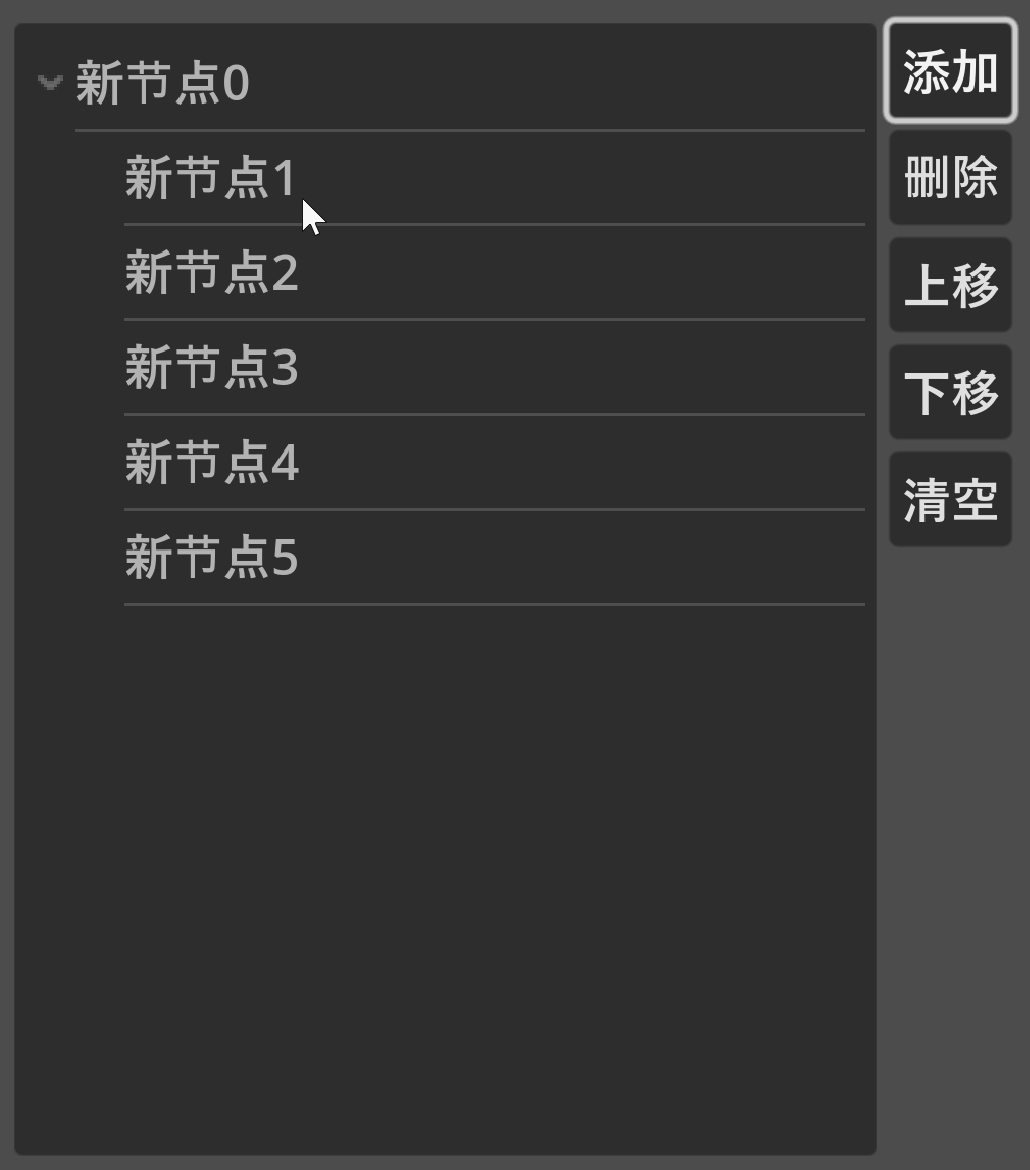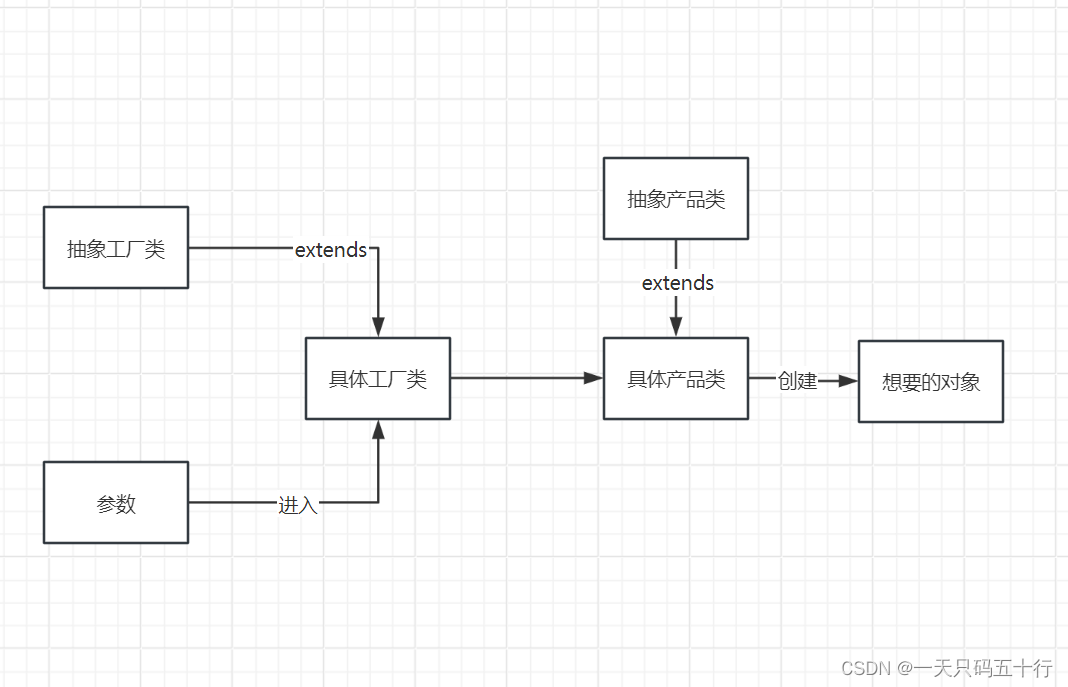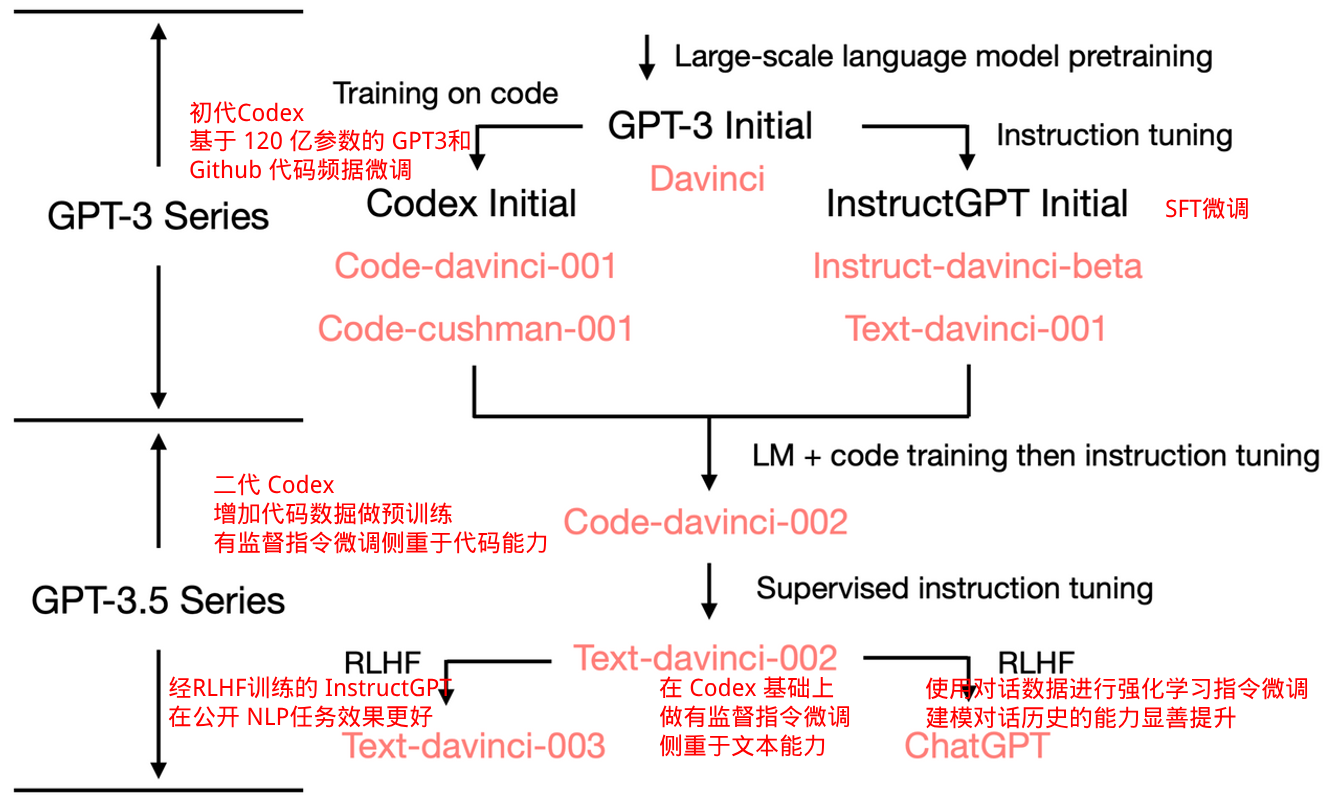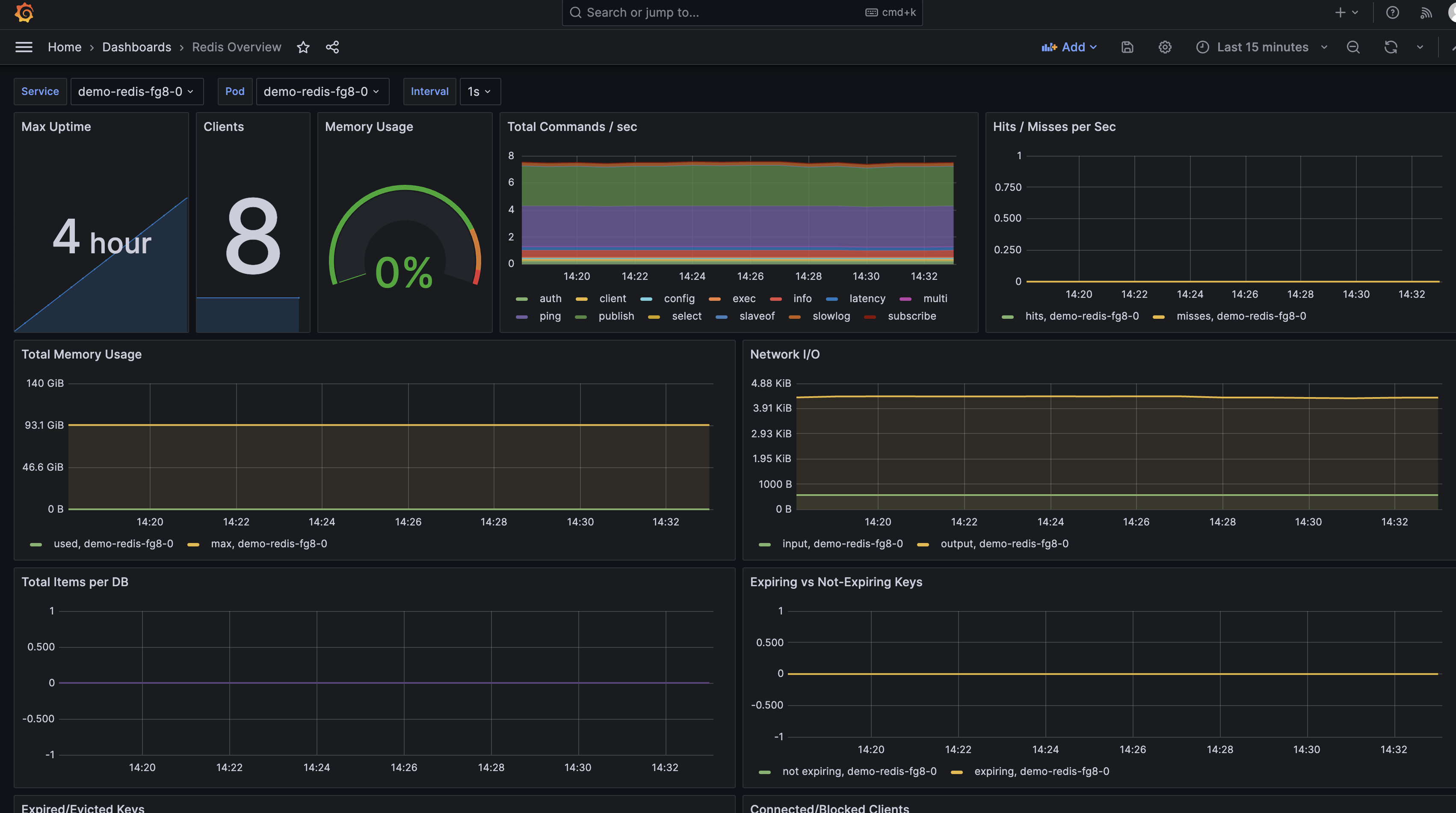核心 API
spark core API 指的是 spark 预定义好的算子。无论是 spark streaming 或者 Spark SQL 都是基于这些最基础的 API 构建起来的。理解这些核心 API 也是写出高效 Spark 代码的基础。
Transformation
转化类的算子是最多的,学会使用这些算子就应付多数的数据加工需求了。他们有啥呢?可以如下分发:
- 转化算子: map、flatMap、filter
- 聚合算子:reduceByKey、reducerBy、groupBy、groupByKey、conbinerByKey、mapValues、flatMapValues
- 连接算子: cogroup、join、union、leftOuterJoin、rightOuterJoin、union
- 排序算子:sortBy、sortByKey
看起来好多,其实就这四种数据加工操作。他们之间又有实现上依赖关系。如下图所示:
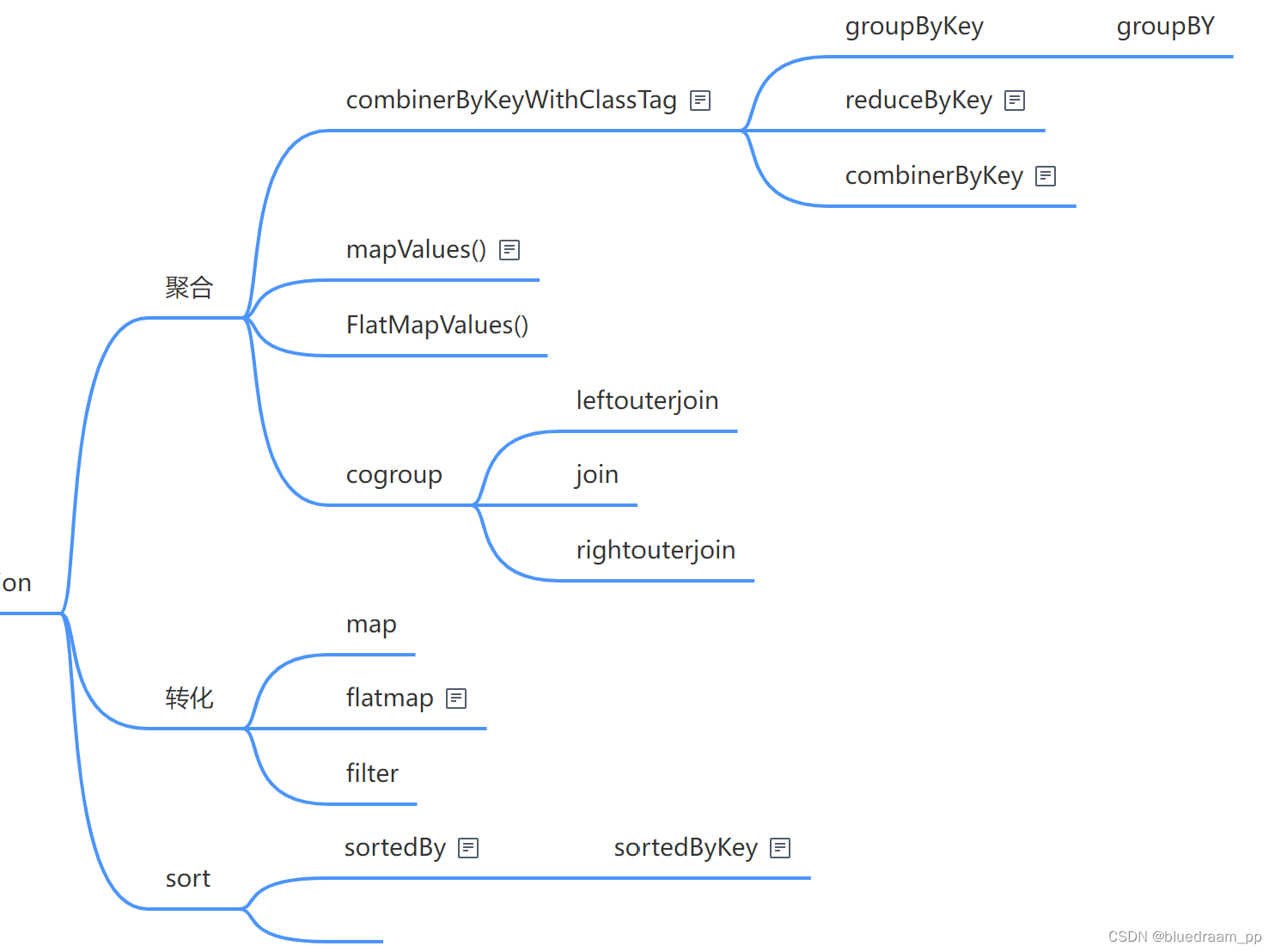
转化算子
在做数据加工的时候,我经常会将某个字段的值进行加工,例如,格式化日期、正则匹配、数据计算、逻辑判断、过滤。 都可以使用转化算子进行加工。举个例子,将过来出 158 开头的手机号,显示出来的电话中间四位替换为*。
import org.apache.spark.{SparkConf, SparkContext}
object CSDN {
def main(args: Array[String]): Unit = {
val conf = new SparkConf().setMaster("local").setAppName(CSDN.getClass.getCanonicalName)
val sc = new SparkContext(conf)
sc.parallelize(List("15899887112"
, "15799887112"
, "15999887152"
, "15799887192"
)).filter(x => x.startsWith("158"))
.map(x => x.substring(0 , 3) + "****" + x.substring(7 , x.length))
.foreach(println);
}
}
总结一下,map 做的事情就是 A -> B ,filter 是过滤的功能。
flatMap 的功能比较难理解,他是这样的,A -> [B , B , B] ,flatMap 返回的是一个数组。还是用一个例子来说明吧。有如下例子,
| group | player |
|---|---|
| Lakers | James,Davis |
| Celtics | Atum,Borrow |
转化为
| player | group |
|---|---|
| James | Lakers |
| Davis | Lakers |
| Atum | Celtics |
| Borrow | Celtics |
代码是:
val conf = new SparkConf().setMaster("local").setAppName(CSDN.getClass.getCanonicalName)
val sc = new SparkContext(conf)
sc.parallelize(List(
("Lakers" , "James,Davis")
,("Celtics" , "Atum,Borrow")
)).flatMap(x => {
x._2.split(",").map(xx => (x._1 , xx))
}).foreach(println)
还有两个和 map 和 flatMap 长的差不多的,分别是 mapValue 和 flatMapValues 两个函数。这两个函数是 PairRDDFunctions 的匿名类中的函数,从 PairRDDFunctions 的名称中可以知道,PairRDDFunctions 是真的键值对的,也就是说 RDD 中的数据是键值对的时候,我们可以调 PairRDDFunctions 的函数,scala 这个功能好像类的被动技能。这是对 RDD 功能一种扩展。说了写废话,还是说回 mapValue 和 flatMapValue ,当这个两个算子接收到 我们字段的函数后,作用到的是 key-value 的 value 上面的, map 和 flapMap 是作用到整个数据上的。例如,我们的数据是 ( James , 37) ,我自定义的函数是 self_define_function , map 和 flatMap 的效果是 self_define_function((James , 37)) , 而 mapValue 和 flatMapValues 则是 (James , self_define_function(value))。
聚合算子
聚合算子包括 combinerByKeyWithClassTag、reduceBykey、reduceBy,然后把数据连接启动的算子:cogroup、join、leftOuterJoin、rightOuterJoin,还有 union 这几个东西。
combinerByKeyWithClassTag 是一个基础类,当明白了它,reduceByKey 和 reduceBy 都会明白了。conbinerByKey 和 Accumulator(累加器) 的计算逻辑一样的。就看一下它的入参吧。
combineByKeyWithClassTag[C](
createCombiner: V => C,
mergeValue: (C, V) => C,
mergeCombiners: (C, C) => C,
partitioner: Partitioner,
mapSideCombine: Boolean = true,
serializer: Serializer = null)
createCombiner : 是一个函数,此函数的入参是 V 返回的是一个 C , V 和 C 是泛型。此函数的功能是创建一个初始值。
mergeValue :也是一个函数,此函数的入参是 C 和 V 返回的是 V ,此函数会接收各个分区每条数据 V ,然后经过加工,返回的还是一个 C 。
mergeCombiner: 又是一个函数,它是合并各个分区 combiner 后的值。
partitioner: 是分区器,它是用来位每条记录计算分区用的。
mapSideCombiner:这个是设置是否在 shuffle 的过程执行,执行 map-side 的局部聚合。
serializer:是数据序列化器,数据在不同的通过网络间传输的时候,需将数据序列化后传输的,这样可以提高效率。
下面
此算子是 PairRDDFunctions 的,所以它是处理 key-value 类型数据的算子。以 word count 为例子。
这需要假设我设置了 mapSideCombine = true 从可以的。
val conf = new SparkConf().setMaster("local[*]").setAppName("");
val sc = new SparkContext(conf)
sc.parallelize(List(
"Java","Spark","Scala","Python","Shell","Lisp"
)).map((_,1)).
combineByKeyWithClassTag(
(x:Int) => x
,(x:Int,y:Int) => x + y
,(x:Int,y:Int) => x + y
,new HashPartitioner(3)
,true
,null
)
.foreach(println)
在上面的的 combinerBykeyWithClassTag 的用户相当于 reduceByKey(+) 的用法,里面的 + 其实 (x:Int,y:Int) => x + y 的简写。
搞聚合的还有一个 groupByKey 和 groupBy() 这两个东西,既然咱们知道了 combinerByKeyWithClassTag 这个函数,其实通过看源码就可以看到 groupByKey 的功能了。
// 进入 PairRDDFunction 对象的 groupByKey 方法里面
def groupByKey(partitioner: Partitioner): RDD[(K, Iterable[V])] = self.withScope {
val createCombiner = (v: V) => CompactBuffer(v)
val mergeValue = (buf: CompactBuffer[V], v: V) => buf += v
val mergeCombiners = (c1: CompactBuffer[V], c2: CompactBuffer[V]) => c1 ++= c2
// 底层就是使用的 combinerByKeyWithClassTag 这个函数
val bufs = combineByKeyWithClassTag[CompactBuffer[V]](
createCombiner, mergeValue, mergeCombiners, partitioner, mapSideCombine = false)
bufs.asInstanceOf[RDD[(K, Iterable[V])]]
}
从源码中,可以看到 groupByKey 底层还是用的 combineByKeyWithClassTag,我来看看它里面三个非常重要的函数:
val createCombiner = (v: V) => CompactBuffer(v)这是初始化 combiner 函数,返回的是一个 CompactBuffer ,这是一个底层保存是数组,这个看以看成是一个 list 。val mergeValue = (buf: CompactBuffer[V], v: V) => buf += v,这个是 mergeValue 的函数,它的做法是将 value 的值放到 CompactBuff 列表的。val mergeCombiners = (c1: CompactBuffer[V], c2: CompactBuffer[V]) => c1 ++= c2,这是 mergeCombiner 的函数,此函数是将两个 CompactBuffer 合并成一个 CompactBuffer 中。
这样算下来,groupByKey 其实是将相同 key 下面的 value 放入到一个 CompactBuffer 中,然后然后在像求什么值,在进行计算就行了。可以使用 mapValues 此函数。这个函数也是 PairRDDFunction 的。
现在再来 groupBy 吧,上源码:
// 打开 RDD 的 groupBy 方法
def groupBy[K](f: T => K, p: Partitioner)(implicit kt: ClassTag[K], ord: Ordering[K] = null)
: RDD[(K, Iterable[T])] = withScope {
val cleanF = sc.clean(f)
// 先使用 map 将 RDD 转化为一个 PairRDD ,然后就可以使用 groupByKey 了
this.map(t => (cleanF(t), t)).groupByKey(p)
}
从代码中可以看到,先是将 RDD 转为 PairRDD ,然后将再使用 groupBykey。转化为 PairRDD 中,使用到 f 这个我们自定义的函数,此函数接收一个 RDD 中的数据,然后返回的是个 key 值,f 其实是定义 key 的函数。
下面看一个例子,
| player | group |
|---|---|
| James | Lakers |
| Davis | Lakers |
| Atum | Celtics |
| Borrow | Celtics |
转化为
| group | player |
|---|---|
| Lakers | James,Davis |
| Celtics | Atum,Borrow |
代码为:
val conf = new SparkConf().setMaster("local[*]").setAppName(this.getClass.getCanonicalName.init)
val sc = new SparkContext(conf)
sc.setLogLevel("ERROR")
val value = sc.parallelize(List(("Lakers", "James")
, ("Lakers", "Davis")
, ("Celtics", "Atum")
, ("Celtics", "Borrow")
))
value
.groupByKey()
.mapValues(x => x.mkString(","))
.foreach(x => println(s"key: ${x._1} , value:${x._2}"))
sc.stop()
// 第二种写法
val value:RDD[(String,String)] = sc.parallelize(List(("Lakers", "James")
, ("Lakers", "Davis")
, ("Celtics", "Atum")
, ("Celtics", "Borrow")
))
value
.groupBy(x=>x._1)
.mapValues(x => x.mkString(","))
.foreach(x => println(s"key: ${x._1} , value:${x._2}"))
sc.stop()
排序算子
排序算子比较少,就两个一个 sortByKey ,另外一个就是 sortBy ,先来看 sortByKey 。
sortByKey 也是一个 PairRDDFunction 的函数,其处理的是 key-value 中的 key ,也就是根据 key 值来进行的排序,看一个例子吧。
sc.parallelize(List("A" , "C" , "B" , "E" , "F" ))
.map((_,0))
// 这里必须设置分区数量为1,否则,打印出来的元素就不排序了。
.sortByKey(true , 1)
sc.stop()
其实,sortBy 就是基于 sortByKey ,来看看源码就知道了。
def sortBy[K](
f: (T) => K,
ascending: Boolean = true,
numPartitions: Int = this.partitions.length)
(implicit ord: Ordering[K], ctag: ClassTag[K]): RDD[T] = withScope {
this.keyBy[K](f)
.sortByKey(ascending, numPartitions)
.values
}
keyBy(func) 可以理解为 RDD.map(x => (func(x) , x)) 其实就是将 RDD 转化为一个 PairRDD , 这样就能用 sortByKey 了,最后把 PairRDD 转化为原来的 RDD 。
连接类的算子
首先要讲的就是 cogroup 算子,它也是一个基础的算子,像 join、lelfOuterJoin、rightOuterJoin、intersection、fullOuterjoin 都是依赖 cogroup 实现的。
看一下 congroup 实现订单表和商品维表关联取出商品价格的情况。
val conf = new SparkConf().setMaster("local[*]").setAppName(this.getClass.getCanonicalName.init)
val sc = new SparkContext(conf)
sc.setLogLevel("ERROR")
val order:RDD[String] = sc.parallelize(List("order1,product1,1", "order1,product2,2", "order1,product3,4"))
val product:RDD[String] = sc.parallelize(List("product1,10", "product2,30", "product3,87"))
val productTuple:RDD[(String,String)] = product.map(x => {
val strings = x.split(",")
(strings(0), strings(1))
})
val orderTuple:RDD[(String,String)] = order.map(x => {
val strings = x.split(",")
(strings(1), x)
})
orderTuple
.cogroup(productTuple)
.mapValues(x => {
x._1.map(xx => {
val strings = xx.split(",")
var rs = ""
var price:Int = 0
if(!x._2.isEmpty){
price = x._2.head.toInt
rs = xx.concat(s",${price.toInt},${price.toInt*strings(2).toInt}")
}
rs
})
}).values.foreach(println)
sc.stop()
再看一下 join 的实现吧
// join 算子是 PairRDDFunction 的
def join[W](other: RDD[(K, W)], partitioner: Partitioner): RDD[(K, (V, W))] = self.withScope {
this.cogroup(other, partitioner).flatMapValues( pair =>
// 笛卡尔积
for (v <- pair._1.iterator; w <- pair._2.iterator) yield (v, w)
)
}
从上面的代码可以知道,是对 pair 进行笛卡尔积操作,而且前后都不为 Seq() ,也就是不为空。
再来看一下 fullOuterJoin 吧。
def fullOuterJoin[W](other: RDD[(K, W)], partitioner: Partitioner)
: RDD[(K, (Option[V], Option[W]))] = self.withScope {
this.cogroup(other, partitioner).flatMapValues {
case (vs, Seq()) => vs.iterator.map(v => (Some(v), None))
case (Seq(), ws) => ws.iterator.map(w => (None, Some(w)))
case (vs, ws) => for (v <- vs.iterator; w <- ws.iterator) yield (Some(v), Some(w))
}
}
从上面的代码里面,发现 fullOuterJoin 的实现和 join 实现差不多,但是多了对应左右列表为空的处理。这和 SQL 这的 full join 的语义是相同的。这个的 case 是 scala 里面的偏函数,在 scala 的源码中应用非常的广泛。
知道了 join 和 fullOuerJoin ,就再来看看 leftOuterJoin 和 rightOuterJoin :
// leftOuterJoin 也是 PairRDDFuntion 的函数
def leftOuterJoin[W](
other: RDD[(K, W)],
partitioner: Partitioner): RDD[(K, (V, Option[W]))] = self.withScope {
this.cogroup(other, partitioner).flatMapValues { pair =>
if (pair._2.isEmpty) {
pair._1.iterator.map(v => (v, None))
} else {
for (v <- pair._1.iterator; w <- pair._2.iterator) yield (v, Some(w))
}
}
}
// rightOuterJoin 也是 PairRDDFunction 的函数
def rightOuterJoin[W](other: RDD[(K, W)], partitioner: Partitioner)
: RDD[(K, (Option[V], W))] = self.withScope {
this.cogroup(other, partitioner).flatMapValues { pair =>
if (pair._1.isEmpty) {
pair._2.iterator.map(w => (None, w))
} else {
for (v <- pair._1.iterator; w <- pair._2.iterator) yield (Some(v), w)
}
}
}
从上面的代码展示来看看,[left | right]OuterJoin 和 SQL 中的 left join 和 right join 的语义也是相同的。
在这里可以得到一个结论,join、leftOuterJoin、rightOuterJoin、fullOuterJoin 的计算效率其实是相同的,都取决于 cogroup 的效率。
最后看一个 RDD 中的函数 intersection
def intersection(other: RDD[T]): RDD[T] = withScope {
this.map(v => (v, null)).cogroup(other.map(v => (v, null)))
.filter { case (_, (leftGroup, rightGroup)) => leftGroup.nonEmpty && rightGroup.nonEmpty }
.keys
}
从上面的代码中可以看到,是去掉了左右没有关联到的数据。这和 SQL 里面的 inner join 的语义是一致的。其实是和 join 逻辑相似,但是并没有将左右边的元素进行笛卡尔积的计算。
在实现维表关联的场景下,还有一个重要的算子,就是 broadcast 算子。来看一个例子。
val conf = new SparkConf().setMaster("local[*]").setAppName(this.getClass.getCanonicalName.init)
val sc = new SparkContext(conf)
//设置文件切分大小
sc.hadoopConfiguration.setLong("fs.local.block.size",128*1024*1024)
//数据合并,有大量的数据移动
val productRDD: RDD[(String, String)] = sc.parallelize(List("product1;10"))
.map { line =>
val field = line.split(";")
(field(0), line)
}
//广播变量
val productBC: Broadcast[collection.Map[String, String]] = sc.broadcast(productRDD.collectAsMap())
//map task 完成数据准备
val orderInfoRDD: RDD[(String, String)] = sc.parallelize(List("order1;10;product1"))
.map { line =>
val field = line.split(";")
(field(2), line)
}
//map 端的join
val resultRDD: RDD[(String, (String, String))] = orderInfoRDD.map {
case (pid, orderInfo) => {
val product: collection.Map[String, String] = productBC.value
(pid, (orderInfo, product.getOrElse(pid, null)))
}
}
resultRDD.foreach(println)
Thread.sleep(100)
sc.stop()
广播是非常好的优化方式,他会将维表的一个副本复制到各个分区里面,然后就可以和进行拉宽做了。
控制类的算子
控制类算子是一类和优化相关的算子。
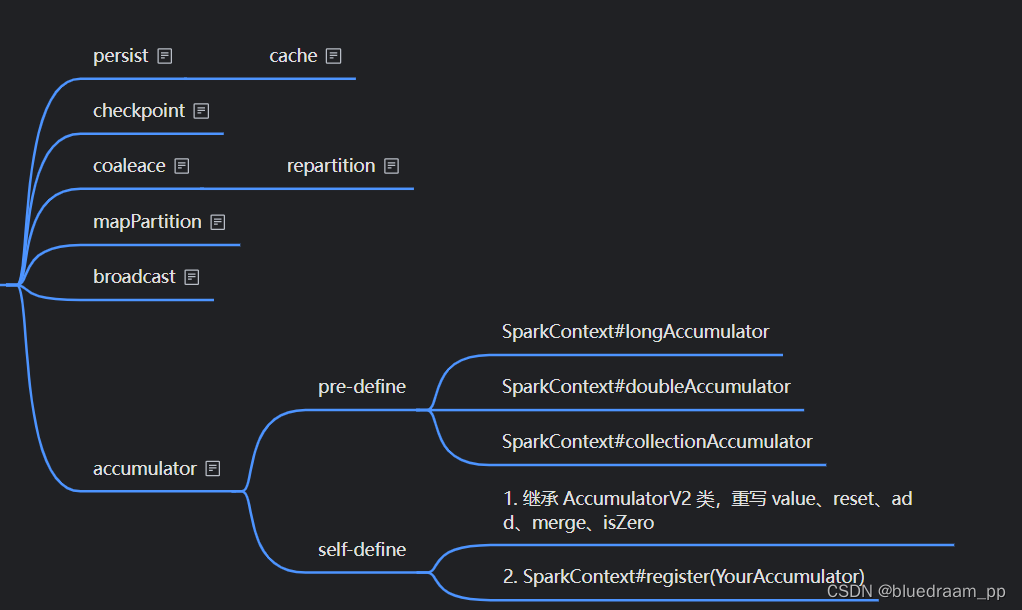
例如,当我们重复利用一些计算结果的时候,可以将中间的计算结果保存到缓存中。例如,我计算某个商品在某些城市的销售额,我们希望计算每天、每周、每月的销售额,我们希望计算这些,怎么计算呢?我们可以计算先计算出每天的销售额,然后在这个基础上计算出每周和每月的销售额。
val conf = new SparkConf().setMaster("local[*]").setAppName(this.getClass.getCanonicalName.init)
val sc = new SparkContext(conf)
sc.setLogLevel("ERROR")
val dimDataRDD:RDD[String] = sc.parallelize(List(
"2024-02-29,1,02"
,"2024-03-01,2,03"
,"2024-03-01,2,03"
,"2024-03-02,2,03"
,"2024-03-03,2,03"
,"2024-03-04,2,03"
))
val dimDateBroadcast = sc.broadcast(dimDataRDD.map(x => {
val strings = x.split(",")
(strings(0), x)
}).collectAsMap())
val orderRDD:RDD[String] = sc.parallelize(List(
"2024-03-01,order1,product1,city1,10"
, "2024-03-01,order1,product1,city3,11"
, "2024-03-01,order1,product1,city4,11"
, "2024-03-01,order1,product1,city5,34"
, "2024-03-01,order1,product1,city3,13"
, "2024-03-01,order1,product1,city3,33"
, "2024-03-02,order1,product1,city3,19"
, "2024-03-02,order1,product1,city4,13"
, "2024-03-02,order1,product1,city5,34"
, "2024-03-02,order1,product1,city3,19"
, "2024-03-02,order1,product1,city1,38"
, "2024-03-03,order1,product1,city5,34"
, "2024-03-03,order1,product1,city3,19"
, "2024-03-03,order1,product1,city1,38"
, "2024-03-04,order1,product1,city5,34"
, "2024-03-04,order1,product1,city3,19"
, "2024-03-04,order1,product1,city1,38"
, "2024-02-29,order1,product1,city1,38"
, "2024-02-28,order1,product1,city1,12"
))
val byDay = orderRDD.map(x => {
val strings = x.split(",")
((strings(0), strings(3)), strings(4).toInt)
}).reduceByKey((s: Int, x: Int) => {
s + x
})
println("====by day city sum(amt)===")
byDay.foreach(println)
val byDayWithMonthAndWeek = byDay.map(x => {
val dimss = dimDateBroadcast.value
val rs = dimss.getOrElse(x._1._1, Nil) match {
case Nil => ("", "")
case str: String => {
val strings = str.split(",")
(strings(1), strings(2))
}
}
//日期+城市 周 月
(x._1, rs._1, rs._2, x._2)
})
byDayWithMonthAndWeek.cache()
println("====by city , week sum(amt)===")
byDayWithMonthAndWeek
.keyBy(x => (x._1._2 ,x._2))
.combineByKey(
(a:((String,String) , String , String , Int)) => a._4
,(s:Int , x:((String,String) , String , String , Int))=>{
s + x._4
},
(x:Int , y:Int) => {
x + y
}
).foreach(println)
println("====by city , month sum(amt)===")
byDayWithMonthAndWeek.keyBy(x => (x._1._2 ,x._3))
.combineByKey(
(a:((String,String) , String , String , Int)) => a._4
,(s:Int , x:((String,String) , String , String , Int))=>{
s + x._4
},
(x:Int , y:Int) => {
x + y
}
).foreach(println)
上面的代码完成了最初的逻辑。我们来看看里面的执行过程。
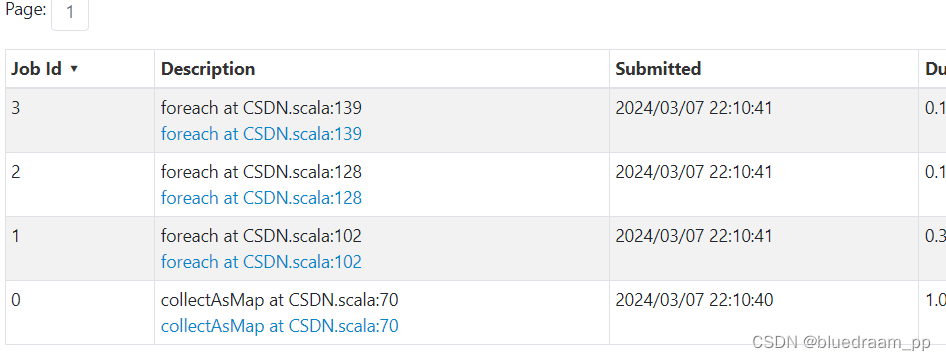
从上面的图中可以看到,有四个 job 执行,从函数来看,
0 号代表广播流
1 号代表了输出的是天、城市粒度下销售额
2 号代表输出的是城市、周粒度下的销售额汇总
3 号代表了输出的是城市、月粒度下的销售额汇总
咱们一个一个点进去看看
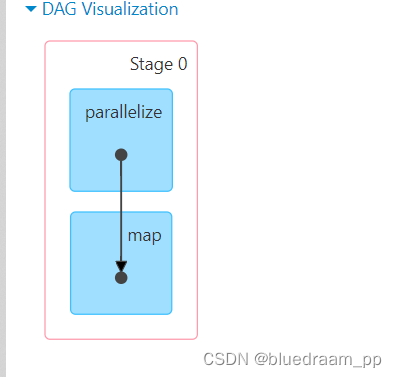
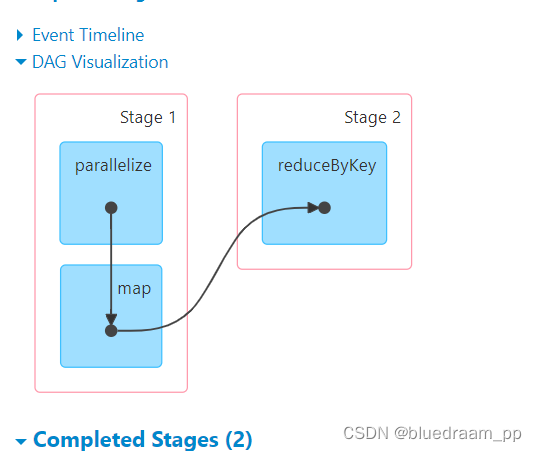


从 2 和 3 中可以看到前面 Stage6 和 stage3 都是 skip 的,在 Stage7 和 Stage8 中的 map 是有一个绿色的标识的,此标识就是代表了使用缓存。如果讲 cache 去掉的话。在来看看效果。
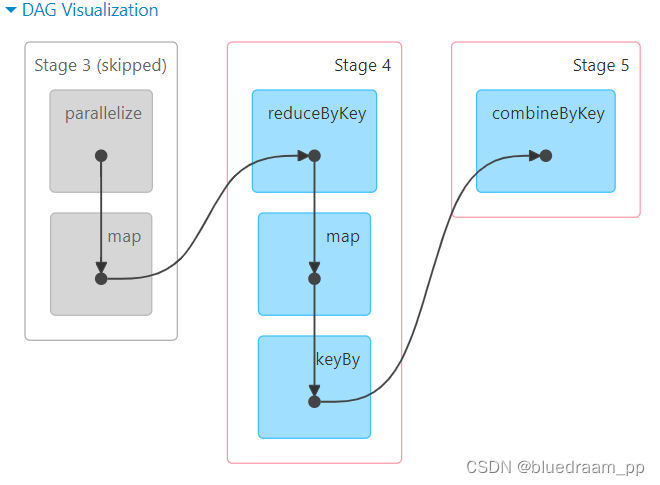
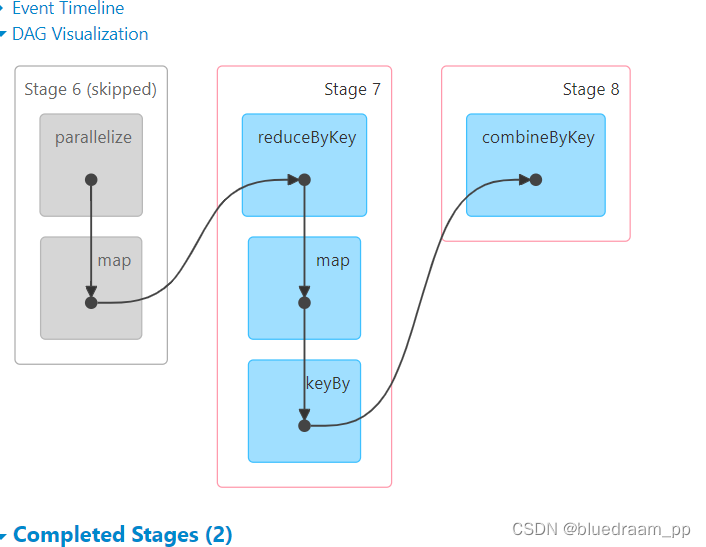
从上面的图中,可以看到 Stage7 和 Stage4 中的 map 没有绿色的标识了,说明缓存已经没了。
下面一个是 persist(), 我们先一个 cache() 的源码:
def cache(): this.type = persist()
def persist(): this.type = persist(StorageLevel.MEMORY_ONLY)
从上面的代码,可以知道,cache 是 persist 实现的,而且 persist 里面可以设置不同的保存级别:
val NONE = new StorageLevel(false, false, false, false)
val DISK_ONLY = new StorageLevel(true, false, false, false)
val DISK_ONLY_2 = new StorageLevel(true, false, false, false, 2)
val DISK_ONLY_3 = new StorageLevel(true, false, false, false, 3)
val MEMORY_ONLY = new StorageLevel(false, true, false, true)
val MEMORY_ONLY_2 = new StorageLevel(false, true, false, true, 2)
val MEMORY_ONLY_SER = new StorageLevel(false, true, false, false)
val MEMORY_ONLY_SER_2 = new StorageLevel(false, true, false, false, 2)
val MEMORY_AND_DISK = new StorageLevel(true, true, false, true)
val MEMORY_AND_DISK_2 = new StorageLevel(true, true, false, true, 2)
val MEMORY_AND_DISK_SER = new StorageLevel(true, true, false, false)
val MEMORY_AND_DISK_SER_2 = new StorageLevel(true, true, false, false, 2)
val OFF_HEAP = new StorageLevel(true, true, true, false, 1)
它起的名字还是见名知意的。所以它可以保存缓存到内存、磁盘、堆外,并且可以序列化。
其实这些都不够安全,最安全的办法就是缓存保存到 HDFS 中。这样就最保险了。也是就有 checkpoint()
spark 的 checkpoint 值是将中间结果缓存,达到中间数据重复使用的效果,和 Flink 对比,Flink 的 checkpint 本质是一种分布式事务,可以协调各个算子完成同一批数据处理,通过checkpoin 就能实现 exactly-once 的语义,但是 spark 就不能这样。
下一个重要的控制算子就是 Accumulator ,它是一个全局性的累计器。可以保存全局性的累计值。下面是是用 accumulator 实现的 workcount。
object TestAccumulate {
def main(args: Array[String]): Unit = {
val conf = new SparkConf().setAppName("test_accumulate").setMaster("local[*]")
val sc = new SparkContext(conf)
val value:RDD[String] = sc.makeRDD(List("Hi,", "Hello", "ww", "hhh"))
val sum:LongAccumulator = sc.longAccumulator("sum")
val accu:MyAccumulator = new MyAccumulator()
sc.register(accu , name = "accu")
value.foreach(x => {
accu.add(x)
sum.add(1)
})
val value1: mutable.Map[String, Int] = accu.value
println(s"size ${value1.size}")
println(s"sum ${sum.value}")
for( (key ,value) <- value1){
println(s"key is ${key} , and value is ${value}")
}
sc.stop()
}
}
class MyAccumulator extends AccumulatorV2[String , mutable.Map[String , Int]]{
// 定义一个集合,来记录以 H 开头的字符串的个数
var map:mutable.Map[String , Int] = mutable.Map[String , Int]()
override def isZero: Boolean = true
override def copy(): AccumulatorV2[String, mutable.Map[String, Int]] = {
val rs:MyAccumulator = new MyAccumulator()
rs.map = this.map
rs
}
override def reset(): Unit = {
this.map.clear()
}
override def add(v: String): Unit = {
if(v.startsWith("H")){
this.map.put(v , map.getOrElse(v , 0) + 1)
}
}
override def merge(other: AccumulatorV2[String, mutable.Map[String, Int]]): Unit = {
val map1:mutable.Map[String , Int] = map
val map2:mutable.Map[String , Int] = other.value
map = map1.foldLeft(map2) {
(map2, kv) => {
map2(kv._1) = map2.getOrElse(kv._1, 0) + kv._2
map2
}
}
}
override def value: mutable.Map[String, Int] = this.map
}
Accumulator 的计算逻辑和 combinerByKey 的逻辑十分的相似。Spark 还为我们预定义了三个累加器,longAccumulator、doubleAcculator、collectionAccumulator 三个,其实现方式也是继承了AccumulatorV2 类,然后,在 SparkContext 中注册就可以使用了。
coalesce 是将 RDD 中的分区重新划分分区,这个的作用可以处理数据倾斜的问题,其实数据倾斜的根源就是在于分区中有多有的少,我们可以使用 key 值的组合,然后重新分区达到各个分区数据量差不多的情况。
action 算子
action 算子是真正出发计算的算子,在 action 算子之前, 所有的算子就像流水线上的一个工序,按照我们想要的结果设置好了加工模具,action 才能够决一个 job 的开始。一个 Spark 任务中,可以有多个 job ,一个 job 里面可以多个 Stage 。
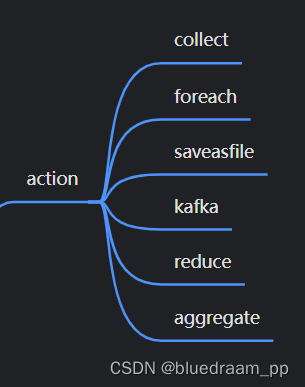
其中,kafka 是后来使用 KafkaUtil 加入的 Kafka 的消费算子,其他都是 RDD 中自带的算子,这些算子中的共同特点是源码中都使用了 SparkContext#runJob()
下面来看看 foreach 函数:
def foreach(f: T => Unit): Unit = withScope {
val cleanF = sc.clean(f)
sc.runJob(this, (iter: Iterator[T]) => iter.foreach(cleanF))
}
下面来说是 KafkaUtils 这是 Spark 扩展,它的功能是让 Spark 可以消费和生产 Kafka 里面的数据,这样 Spark 就能处理流式计算了。
数据源算子
数据源算子是设置数据源的算子。
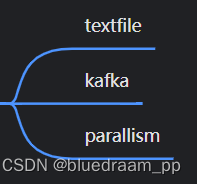
textfile 是从文件系统中取出数据,可以是 disk 中,或者从 HDFS 中拉出来。
parallism 是可以从 List 消费数据,这个算子经常用来测试功能。

